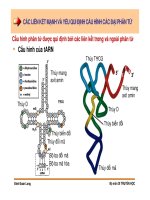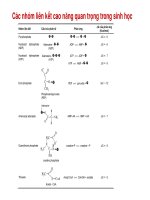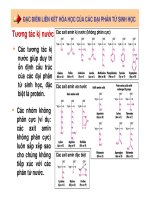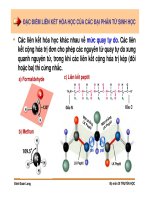Cau truc te bao va cac dai phan tu
Bạn đang xem bản rút gọn của tài liệu. Xem và tải ngay bản đầy đủ của tài liệu tại đây (2.67 MB, 54 trang )
GIỚI THIỆU
•
Sản xuất protein tái tổ hợp là sự biểu hiện
các protein bằng các kỹ thuật tái tổ hợp
DNA. Quá trình này cho phép thu nhận các
protein với sản lượng cao.
•
Kỹ thuật này thường được dùng để sản xuất
các dược sinh học cho người và thú y.
GIỚI THIỆU
•
Protein là những chuỗi axit amin, được mã hóa
bởi DNA. Các gen mã hóa cho các protein này
sẽ được đặt vào các vector đặc biệt có khả
năng sản xuất một lượng lớn protein. Điều này
được gọi là overexpression.
•
Overexpression được thực hiện bởi 1 số hệ
thống tế bào như vi khuẩn, nấm men,…
Dược sinh học
•
Nguồn thu nhận hiếm và chi phí cao
–
Khó cung cấp đủ nhu cầu
–
Khó tách chiết sản phẩm
–
Có khả năng gây đáp ứng miễn dịch
–
Kháng virus, tác nhân gây bệnh
•
Hầu hết các protein dược sinh học hiện nay
đều được sản xuất bằng kỹ thuật tái tổ hợp
gen vì:
- Chi phí thấp, sản lượng cao
CẤU TRÚC CỦA TẾ BÀO
PROKARYOTE VÀ EUKARYOTE
Living Domains
Living Domains
CẤU TRÚC TẾ BÀO PROKARYOTE
CẤU TRÚC TẾ BÀO PROKARYOTE
Vi khuẩn
Vi khuẩn
CẤU TRÚC TẾ BÀO EUKARYOTE
CẤU TRÚC TẾ BÀO EUKARYOTE
TẾ BÀO, MÔ, CƠ QUAN
TẾ BÀO, MÔ, CƠ QUAN
(Động vật)
(Động vật)
TẾ BÀO, MÔ, CƠ QUAN
TẾ BÀO, MÔ, CƠ QUAN
(Thực vật)
(Thực vật)
Prokaryotes vs. Eukaryotes
Prokaryotes vs. Eukaryotes
Prokaryotes Eukaryotes
Typical organisms Bacteria, archaea Protists, Fungi, Plants, Animals
Typical size ~ 1-10 µm ~ 10-100 µm
Type of nucleus Nucleoid region, no real Real nucleus with double membrane
DNA Usually a single circular
chromosome
Linear chromosomes packed with histone
proteins
RNA-protein
synthesis
Coupled in cytoplasm RNA-synthesis inside the nucleus, protein
synthesis in cytoplasm
Ribosomes 50S+30S 60S+40S
Cytoplasmatic
structure
Very few structures Highly structured by endo-membranes
and a cytoskeleton
Mitochondria None One to several dozen
Chloroplasts None In algae and plants
Organization Usually single cells Single cells, colonies, higher multi-cellular
organisms with specialized cells
Cell division Binary fission (single
division)
Mitosis (fission or budding) and Meiosis
Prokaryotic Chromosome
Prokaryotic Chromosome
Eukaryotic Chromosomes
Eukaryotic Chromosomes
Different types of viruses
Different types of viruses
Structure of HIV
Structure of HIV
Viruses .... Không phải là sinh vật sống
Viruses .... Không phải là sinh vật sống
Viruses use the transcription and translation machinery of host cells for
propagation and protein synthesis and assembly of new viral particles.
•
Penetration of viral
particle
•
Reverse transcription
from viral RNA
•
DNA replication
•
Protein synthesis
•
Assembly
•
Secretion of new
viral
particles
Nhân tế bào
Nhân tế bào
Organelle that contains most of the cell's genetic material, organized as
multiple long linear DNA molecules in complex with a large variety of
proteins, such as histones, to form chromosomes (nuclear genome). Its
function is to maintain the integrity of these genes and to control the
activities of the cell by regulating gene expression.
Màng và lỗ nhân
Màng và lỗ nhân
A double membrane that encloses the Nucleus and keeps its contents
separated from the cellular cytoplasm, and the nuclear lamina, a meshwork
within the nucleus that adds mechanical support. Nuclear pores crossing
both membranes allow movement of small molecules across the envelope.
The movement of larger molecules such as proteins is carefully controlled.
Hạch nhân
Hạch nhân
A discrete densely-stained structure found in the nucleus. It forms around
tandem repeats of rDNA, DNA coding for ribosomal RNA (rRNA). The
main roles of the nucleolus are to synthesize rRNA and assemble
ribosomes.
Mạng lưới nội chất trơn và nhám
Mạng lưới nội chất trơn và nhám
An interconnected network of tubules, vesicles and cisternae, and is
responsible for several specialized functions: Protein translation, folding,
and transport of proteins to be used in the cell membrane, or to be
secreted from the cell. Attached ribosomes give the appearance of “rough”
part of the ER.
Bộ máy Golgi
Bộ máy Golgi
An organelle found in most eukaryotic cells. Its primary function is to
process and package the macromolecules such as proteins and lipids
that are synthesized by the cell. It is particularly important in the
processing of proteins for secretion.
Different parts of the Golgi
apparatus: cis-, medial- and
trans- cisternae
cis-Golgi
cisternae
medial-Golgi
cisternae
trans-Golgi
cisternae
Ti thể
Ti thể
A membrane-enclosed organelle found in most eukaryotic cells, that
generates most of the cell's supply of ATP, a source of chemical energy.
The number of mitochondria in a cell varies widely by organism and tissue
type. Although most of a cell's DNA is contained in the cell nucleus,
mitochondria have their own independent genomes.
Lysosome
Lysosome
Organelles that contain hydrolytic enzymes (acid hydrolases).
Peroxisome
Peroxisome
An organelle that contains the enzyme catalase and other enzymes.
It is responsible for many oxidizing reactions.









